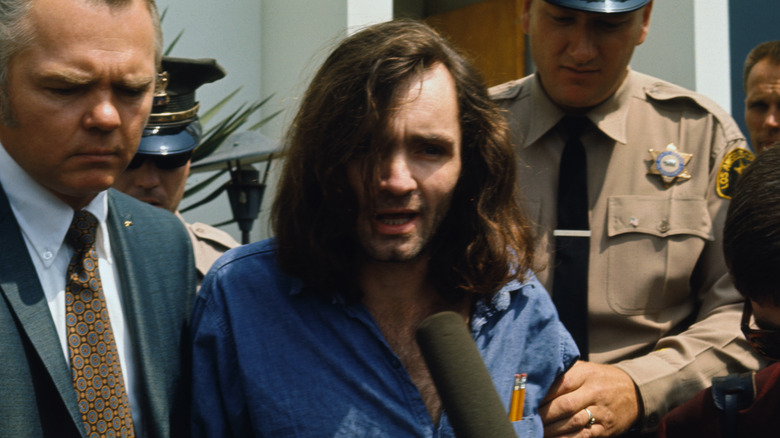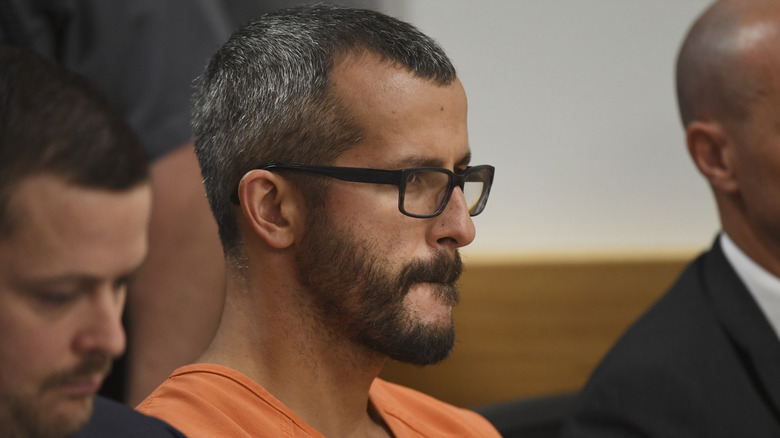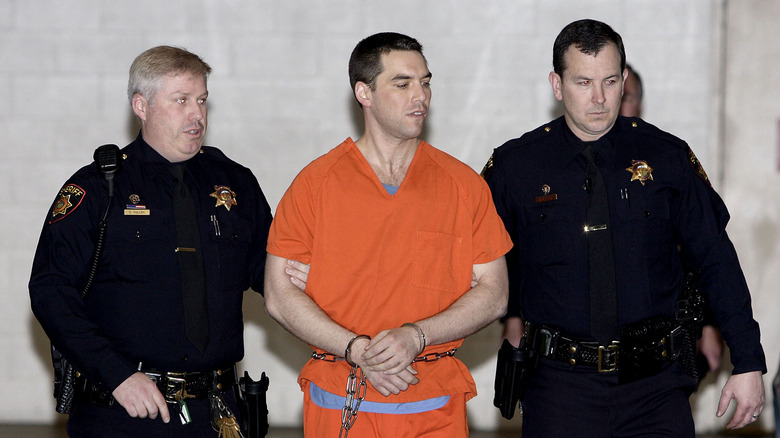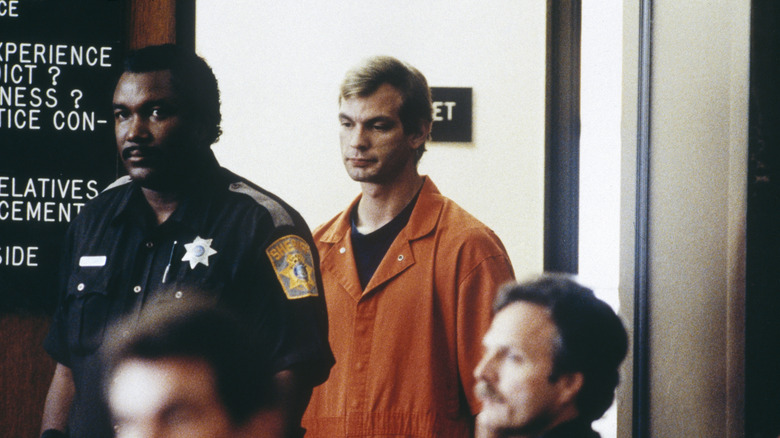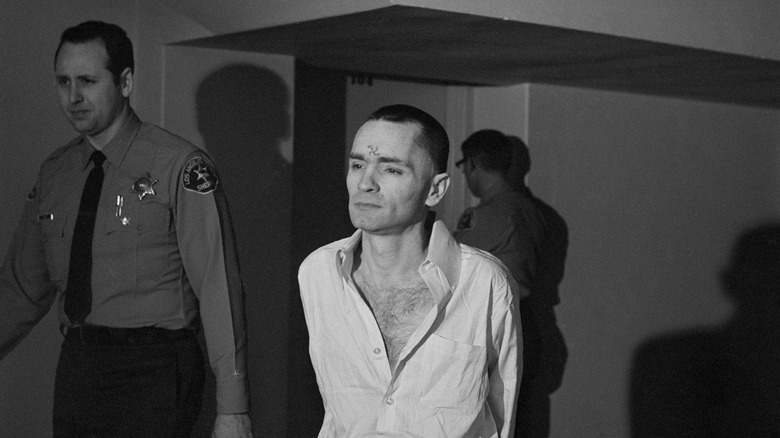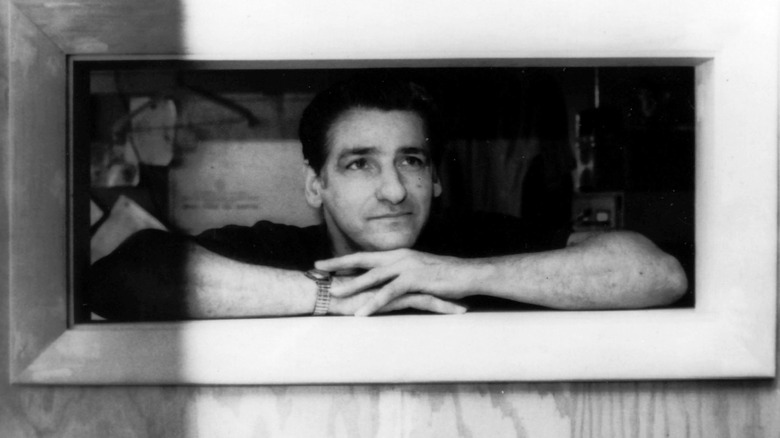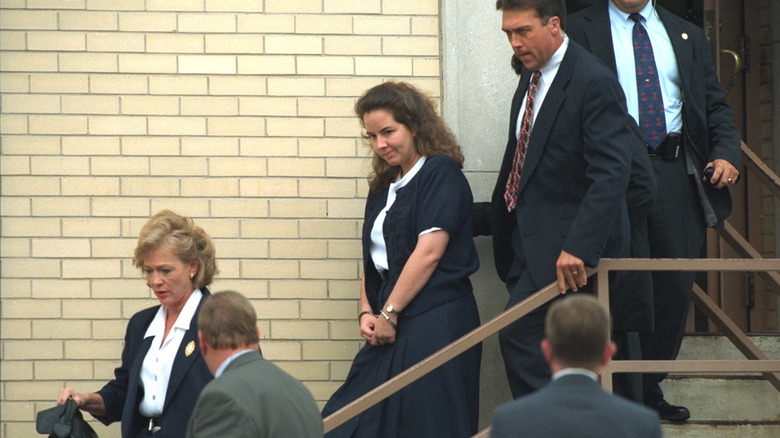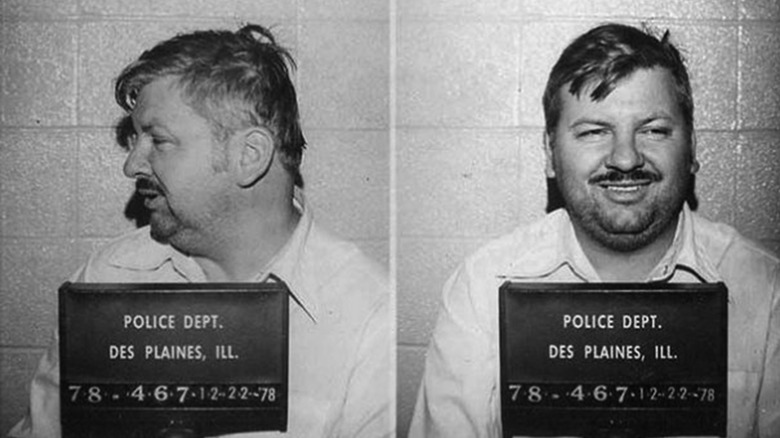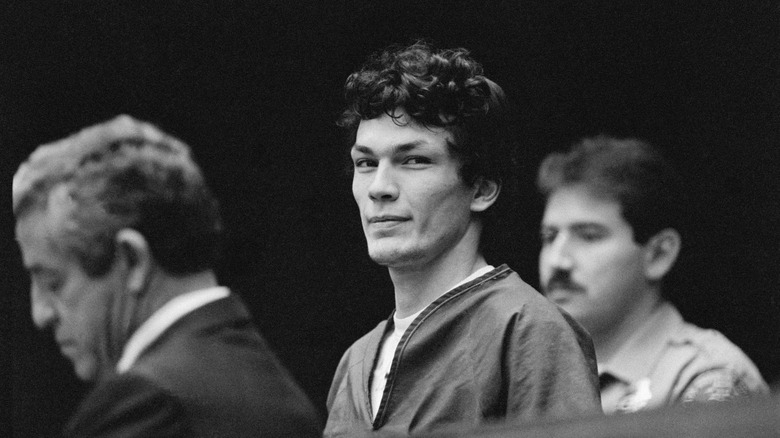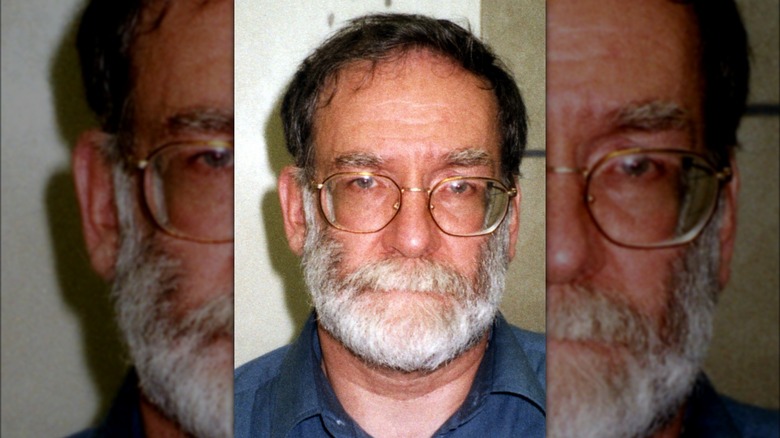These Notorious Killers' Cellmates Have A Lot To Say About Them
Most people are never going to commit a crime so serious that they end up in prison, let alone in a cell with one of history's most notorious murderers. But imagine, for a moment, that somehow you did. Think of the things you would see and hear in that situation, things maybe even the cops and prosecutors didn't know, or personal details any true crime podcast would pay dearly to learn. Would you go public with that information? Considering how many cellmates of notorious prisoners couldn't keep their secrets, the answer is ... probably.
Thanks to prison employees, former cellmates, and fellow inmates banged up with some of the most infamous killers to ever live, we know some unexpected details about their crimes and personalities. However, this information needs to be considered in the context it is given. Criminals are known to lie, after all, and in many cases, they have been paid for their stories by tabloid newspapers. So, while we don't have to assume everything they say is made up, some of it — especially the dramatic stories of confessions — should be taken with a grain of salt.
Still, sharing a cell with someone that you know is manipulative, dangerous, and unrepentant must be terrifying, even for the hardened criminals who had to do it. Here's what these notorious killers' cellmates had to say about them.
The following article mentions suicide and descriptions of sexual assault.
Jodi Arias
In 2013, Jodi Arias was convicted of violently murdering her ex-boyfriend in what was one of the most-watched court cases in TV history. While Arias maintained she killed Jason Alexander in self-defense, she was sentenced to life in prison.
Two inmates who spent time with her in jail were Donavan Bering and Tracy Brown. The two were in a relationship behind bars and are now married. From their close contact with the murderer, they came away with the impression she was very manipulative and especially good at using her sexuality to get what she wanted. Bering told 3TV/CBS 5, "The male guards really liked her. But then she flirted a lot. She was very sexual, very sensual. She would always pose in certain ways ... She got a lot of stuff, that the other inmates didn't get."
She also manipulated people in other ways. "She was so innocent, she seemed so meek and scared and she just didn't have a hard side to her at all," Bering said. Interviewed in Lifetime's docuseries "Jodi Arias: Cellmate Secrets" (via Oxygen), Brown said Arias used a threat of dying by suicide to manipulate her into allowing Arias to ink a disturbing prison tattoo: "I agreed to let Jodi put her name on my leg because I was convinced she was going to kill herself." It was surrounded by a songbird because Brown said Arias had a beautiful voice and sang to her each night. What she didn't have, Bering says, was any remorse for the murder she committed.
Chris Watts
Chris Watts pled guilty to killing his pregnant wife and two young daughters in 2018. However, behind prison walls, he claimed it hadn't been his fault.
David Carter was Watts' cellmate for a time in the Dodge Correctional Facility. He told The U.S. Sun, "One day we were reading the Bible and talking about God ... I told him that I couldn't judge him for what had happened, but I'd like to know what was going through his head." According to Carter, Watts said it was really his mistress who "had smothered the girls with their blankets and they suffocated."
Watts also accused his wife Shanann of being the one who killed their children. Cheryln Cadle, author of "Letters from Christopher: The Tragic Confessions of the Watts Family Murders," visited him in prison to clear Shannann's name. What she saw was a man broken from isolation and trauma since incarceration. "He'd lost his physique, was almost bald ... He was a very different man," she told MediaVillage. In the Lifetime docuseries episode "Cellmate Secrets: Chris Watts' Chilling Confessions," Cadle explained, "Our first face-to-face meeting he was a little shy, was nervous so I noticed ... every time I would ask him a question he would look down or if he was telling me about what had happened he would look down." Despite his meek appearance, she believes he was still trying to manipulate her.
Scott Peterson
Scott Peterson was convicted of the 2002 murder of his 8-months-pregnant wife Laci and her fetus in 2004. He has maintained his innocence, and as of 2024, is working with the LA Innocence Project to get access to evidence he believes will clear his name.
However, according to James Soares, the inmate in the adjoining cell in the jail Peterson was held at before his conviction, there was one time they were drinking illicit prison-made alcohol when Peterson seemingly made a confession. "We were on our third or fourth glass, watching TV, when the news came on about Laci when suddenly Scott blurted out, 'I didn't mean it, Jimbo. I swear to God — I didn't mean to kill my wife. It was an accident.' Scott's voice was filled with emotion," Soares told the tabloid Globe. "He told me, 'I feel like killing myself ... it's killing me inside.'" As the case progressed badly for Peterson, his attitude changed. After one day in court, "Scott was in a foul mood," Soares said. He claims Peterson started complaining, "It's all my wife's fault ... It's her fault I'm in this mess."
Once on death row in San Quentin, Peterson hung a picture of himself and Laci in his cell and played basketball and cards many hours a day. "There are a group of guys that he hangs with," prison guard Samuel Robinson told People, "but it's not anyone of any [criminal] notoriety."
Jeffrey Dahmer
While the notorious Jeffrey Dahmer did not have a cellmate, he did interact with other inmates, which resulted in him being one of the many serial killers who were killed in prison. While on work duty in 1994, with Dahmer and wife-murderer Jesse Anderson, Christopher Scarver attacked and killed them both. In 2015, Scarver claimed it was because Dahmer would use food to freak out other prisoners and remind them he was a cannibal. "He would put [it] in places where people would be," Scarver told the New York Post. "He crossed the line with some people — prisoners, prison staff. Some people who are in prison are repentant — but he was not one of them." However, it is worth noting this was the first time Scarver gave this reason, and even his own lawyer doesn't believe it.
That is not to say Dahmer didn't mess with people while incarcerated. His former prison minister Pastor Roy Ratcliff told the same tabloid that Dahmer would threaten to bite guards, and even hung a sign in his cell that read "Cannibals Anonymous Meeting Tonight." Ratcliff said, "He sort of played with his persona to exaggerate it and make people more fearful. This was just his way — a morbid humor to deal with his hopeless situation."
He wasn't always awful, allegedly. In a now-unavailable Instagram post, transcribed by Esquire, R&B artist and former convict Lyfe Jennings claims he met Dahmer in prison, where the serial killer requested he sing him Mint Condition's "Breakin' My Heart (Pretty Brown Eyes)."
Charles Manson
In his autobiography "Trejo: My Life of Crime, Redemption, and Hollywood," actor Danny Trejo writes about meeting Charles Manson in prison in 1961, years before the murders that would make Manson a household name. Trejo remembers Manson as "a greasy, dirty, scrawny white boy," who guided the actor and another inmate in meditation sessions that Trejo says felt like being high on drugs. "If that white boy wasn't a career criminal, he could have been a professional hypnotist," Trejo wrote, "someone who went to high schools and state fairs and got people to come onstage and act like cats and stuff."
Another cellmate who knew Manson in the early 1960s was Phil Phillips. When interviewed for the 1973 documentary "Manson," Phillips said, "When we were celling together, we used to lay in bed at night and talk about what we were going to do when we got out ... you don't have anything else to do at night except talk about the future. Everybody seemed to think Charlie was just kind of a guy to have around to make fun of."
Once he was convicted for the 1969 Tate-LaBianca murders, Manson didn't have a cellmate. However, he hung out with the other notorious murderers — including RFK assassin Sirhan Sirhan — with whom he was housed in a special section of Corcoran State Prison. Described by a prison spokesperson to ABC News as "not what we would describe as a model inmate," Manson spent a lot of time playing the guitar.
Albert DeSalvo
The murderer known as "The Boston Strangler" was one of the most dangerous serial killers of the 1960s. Between 1962 and 1964, at least 11 women were strangled to death with their own clothing, and many of them were raped before their murders. Back then, there was no way to conclusively prove who did it, but George Nassar, a former inmate alongside Albert DeSalvo, insists the latter confessed to him in detail.
"He convinced me by the description. He was getting it off his chest. I was the first person, apparently, to who he had really spoken about specifics of each crime," Nassar told WBZ-TV in 2018. His story has remained consistent over the years, with Nassar telling The Boston Globe in 1995 (via The New York Times), "[DeSalvo] began describing a crime and watching my reaction to see if it was too abhorrent to listen to. Some of it was horrible, particularly the crimes of stabbing a woman under her breasts in Cambridge. But I wasn't there to condemn." Despite this alleged confession, no one was ever convicted for The Boston Strangler murders. It was only in 2013 that DNA advances managed to tie DeSalvo conclusively to one of the killings, although it is still not known for sure if he committed all — or any — of the others.
While incarcerated, DeSalvo made jewelry but managed to make his hobby creepy. "He got into necklaces; he called them chokers. And everyone had a big laugh. I didn't find that funny at all," Nassar said.
Susan Smith
In 1994, young mother Susan Smith claimed a Black man carjacked her, taking off with her 3-year-old and 14-month-old sons. In reality, she had strapped them in their car seats and rolled the car into a lake. It was a horrific crime, and she was sentenced to life imprisonment.
Once she was convicted, Susan shared a cell with Christie Smith — no relation. The experience was weird for Christie. "Susan was very delusional and I would notice that she would have conversations like the kids were still alive," the former prisoner told the Lifetime docuseries "Cellmate Secrets" (via InTouch Weekly). "One Saturday morning, we got up. She had the little photo album out — she loved having that photo album out. She had a cup of coffee in her hand and she was just talking to the photo album. She was like, 'It's OK, Michael's going to take care of you guys. I know he is.' And I was like, 'What is she saying? Them kids are not going to come back.'"
But as the years have passed, Susan has found a way to have a good time while incarcerated: She's been disciplined multiple times for having sex with guards and misusing drugs, and has had relationships with other prisoners. Christie told the National Enquirer, "[Susan] really has it made in prison. She's popular with other inmates, teaches GED classes, and has a full-time lover. She certainly has it a lot better than her boys, who never really lived."
John Wayne Gacy
Considering how heinous and numerous his crimes were, one would not assume that serial killer John Wayne Gacy would be a model prisoner after he was convicted of 33 murders in 1980, but he was. According to Judge Peter Van Metre (via "The Man Who Killed Boys: The John Wayne Gacy, Jr. Story" by Clifford L. Linedecker) who had overseen an earlier trial of Gacy's, the explanation for this was the same thing that allowed the murderer to live a normal middle-class life while on his killing spree: Gacy "behaves himself when people are watching him and he is under the gun."
Indeed, he was such a good prisoner that he received every luxury allowed inside, including a TV in his cell. His fellow inmates thought this was unfair and filed an official complaint in 1982. But Corrections Department spokesman Nick Howell told UPI that Gacy was entitled to the perks for his behavior, and gave an example: "A few months ago, some of the inmates tore up the visiting room pretty good. Gacy went in and cleaned that stuff up."
One thing that could make him act out was fear of sexual assault. Former inmate Ray Cornell who was in jail with Gacy in the 1960s, explained in the Netflix docuseries "Conversations With a Killer: The John Wayne Gacy Tapes" (via The Daily Mail), "He's struggling with his sexual urges ... That came out in my opinion. That came out in his personality as anger, as rage."
Richard Ramirez
Between 1984 and 1985, the "Night Stalker" terrorized the Los Angeles area, breaking into homes before sexually assaulting and/or murdering the occupants. After police found a fingerprint he left behind, Richard Ramirez was finally caught. In 1989, he was convicted of 13 murders and sentenced to death, although he died of cancer before his sentence was carried out.
Death row inmates don't have cellmates, but Ramirez did sort of befriend fellow inmate Martin Kipp. In a video call from prison, Kipp spoke with The Lighter Side Of Serial Killers podcast about Ramirez (lightly edited for clarity): "He would draw pentagrams under his bunks and he would chant. When I was in Orange County, I'd ask him why do you do that? He goes, 'Well, that's where I get my messages ... I got a master, you know' ... That's the thing that people don't realize, right, he would chant, you know ... to get his guidance ..."
Kipp also spoke to Inside Edition and explained what Ramirez told him about his violent sexual fantasies. Behind bars, the serial killer seemed to get his kicks by exposing himself and performing sex acts in front of visitors, including children. San Quentin spokesperson Lt. Sam Robinson told The Daily Beast, "All of his visits were behind a partition. He wasn't allowed to touch someone or hug them. ... He would also expose himself inside the housing unit to guards. We put signs in front of the cell saying he has the propensity to do that."
Harold Shipman
Harold Shipman was a British doctor who was convicted of murdering 15 of his patients, although an official inquiry determined the real number was probably closer to 250. He never officially confessed to any of the murders, and according to those who knew him on the inside, he remained arrogant beyond belief while behind bars.
Jon Harkin was a fellow inmate trained to listen to other prisoners in an attempt to improve their mental health. Despite a rule these listening sessions were confidential, eventually, Harkin spoke at length to the Lancashire Telegraph about what being in a cell overnight with Shipman was like. "He was so full of himself, so arrogant, as if he was on a pedestal, laughing at the police and the medical profession. I asked him why he took their lives. He kept saying that he had the power, that they were 'acts of God.' It wasn't a confession, it was more like a boast." His experience with the serial killer clearly affected Harkin deeply. He said, "My time listening to Shipman was horrendous. I've been physically ill and my memories of being locked in a cell with him have given me many sleepless nights."
Shipman knew nothing about how prisons worked and was shocked he was expected to clean his own cell. He listened to classical music, cheated at Monopoly but legitimately won at Scrabble, and did coursework in history. Harkin remembered, "He was obviously very intelligent and he would sometimes use big words and talk down to me."
James Earl Ray
On April 4, 1968, Martin Luther King Jr. was shot and killed, sparking an intense manhunt for his assassin, James Earl Ray. In order to attempt to locate the murderer, the FBI conducted interviews with almost 100 inmates he'd been locked up with for previous crimes. While not all of the stories are believable, the most credible ones describe Ray as a violent racist. He was also involved in dealing drugs in prison, as well as using them himself.
Getting contraband was something of a skill of Ray's. "He was a peddler at Jeff City, all right," fellow inmate Raymond Curtis told the author George McMillan in 1975 (via Time). "I've seen him work on a plan as long as 30 days to get a dozen eggs halfway across the prison yard. He stole many a case of eggs in his time, sold them for $1 a dozen, $30 a case ... Sometimes we made raisin jack, sometimes homemade beer. Ray supplied the yeast because he could get it in the bakery, where he worked ..."
Another inmate remembered Ray as a hypochondriac who worried about heart palpitations and took lots of pills. Not everyone disliked Ray, though. One former prisoner, whom the reporter calls Mr. Curtis, was interviewed before Ray was finally captured in London on June 8. The man said, "[Ray] was a likable sort of person. He did no foolish conversations, and when he talked about something he was serious about it ..." (via Hezakya Newz & Films).
If you or anyone you know has been a victim of sexual assault, or is struggling or in crisis, contact the relevant resources below:
-
The Rape, Abuse & Incest National Network website or contact RAINN's National Helpline at 1-800-656-HOPE (4673).
-
Call or text 988 or chat 988lifeline.org
